Roads, Highways, and Ecosystems
John Stilgoe, Harvard University
©National Humanities Center |
|
(part 3 of 6)
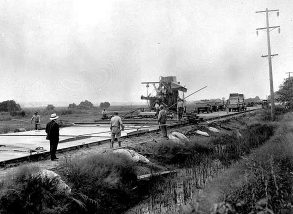 |
Laying concrete highway,
1923
| K. L. Fenney Co.
Minnesota Historical Society |
"What does improved roads mean?
. . . . almost all were raised,
ditched, and graded."
|
|
|
 |
What does improved
roads mean? Not every improved road
had a concrete surface, and the newer, and perhaps cheaper, petroleum surface
called asphalt. Many improved roads
were paved with crushed stone, and many others were graveled. But almost all were raised, ditched,
and graded.
Raised roads. A road raised
above the abutting land is technically a highway. Such roads existed in antiquity, and indeed
the Roman empire depended on a network of paved roads elevated above adjacent ground. Only main roads crucial to an empire or kingdom stood proud, elevated a foot or so above the natural topography.
 |
|
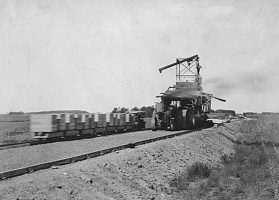 |
Road paving, 1920
| Minnesota Historical Society |
"A road raised above the abutting land
is technically a highway."
|
|
 |
Such roads, incredibly
expensive to build and maintain, carried special legal status. Knights and sheriffs policed them at the
behest of emperors and kings, and even today the phrase highway robbery endures to mark a sort of robbery that insults a king. A medieval peasant robbed on an ordinary road demanded justice, certainly, but a peasant robbed on the king’s highway knew that the bandit had insulted the royal offer of protection to all
travelers and that his crime would mean the arrival of sheriffs and even troops
if necessary. And too, any king knew
that having highways meant having to honor the promise of royal protection not
only against bandits but against mud holes and washouts.
 |
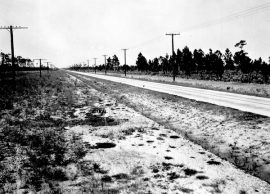 |
Florida, 1935
| Florida State Archives |
"Elevating a road meant simply that it drained during and after rain, that
it did not turn to
mud."
|
|
|
 |
Elevating a road
meant simply that it drained during and after rain, that it did not turn to mud. Travelers expected a highway to be free of mud, and free of ruts too, and they expected the well-drained road surface to stay smooth during cold weather, to remain free of frost heaves. The American colonists knew few such roads, although here and there a long-distance road might be called a royal highway. After independence the Constitutional Convention, fearing the tyranny implicit in any national
government capable of building highways and knowing the horrendous difficulty of building and maintaining roads in a vast, still half-settled land, expressly
forbade Congress from building highways. Well into the nineteenth century, as Andrew Jackson and other presidents struggled with legal problems involving the National Road, and as turnpike companies built and maintained private toll roads, Congress, the Supreme Court,and state governments argued about the legal intricacies of building highways. But after the 1840s, interest waned. The railroad industry solved the
road problem.
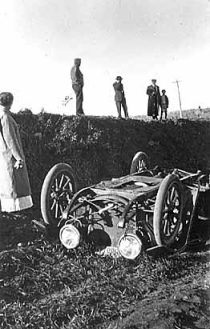 |
1915
| Emil King
Minnesota Historical Society
|
"Who accepted responsibility for accidents caused by poor-quality roads? The motorist? The county government? No one?"
|
|
|
 | In the first years of the twentieth century all the old legal questions resurfaced from the past, as motorists demanded better and better roads, especially highways elevated above surrounding land. Early
automobiles rode high on their wheels, in part to protect undercarriages from being struck by rocks, in part to keep wheel hubs out of the mud. High-riding automobiles tended to tip over easily, however, and soon motorists and manufacturers alike demanded smoother roads so that cars might ride closer to the ground. Who accepted responsibility for accidents caused by poor-quality roads? The motorist? The county government? No one? At the beginning of the twenty-first century, American motorists often favor large, high-riding, four-wheel-drive sport utility vehicles out of the thinking that originated in 1910. Better to drive above the rock or through the mud now than damage the
car and sue later, they reason, in a way that Henry Ford would have understood.
Slowly, reaching out from cities into suburbs, and from large farm towns into rural regions, reached the first elevated roads, the first highways on which motorists could expect a fairly well-drained surface. Elsewhere, if they were lucky, motorists found ordinary gravel roads and even dirt roads improved only by ditches.
 |
|
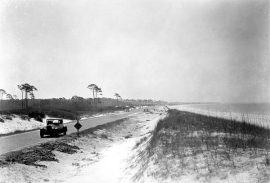 |
Highway 10 near
Panama City, 1936
| Florida State Archives |
"Ditches help roads to drain, even when
roads are not elevated much"
|
|
 |
Ditches. Ditches help roads to drain, even when roads are not elevated much, if at all, above abutting land, but even in
pre-Civil War turnpike days, ditches presented serious problems. In heavy rains, ditches fill, then flood, and sometimes turn into miniature rivers whose currents erode roads. Always they represent a danger to anyone, teamster or motorist, veering away from the center of the road. In the early years of automobiling, motorists whose brakes failed sometimes deliberately steered into ditches rather than collide with livestock or other vehicles. To ditch meant the deliberate wrecking of a car in order to stop it, and eventually the word carried over into airplane slang: today pilots still ditch planes, especially
in the ocean. To be ditched, however, meant being run into a ditch by another motorist, and the phrase carried over into much early twentieth-century slang, especially that involving love affairs.
 |
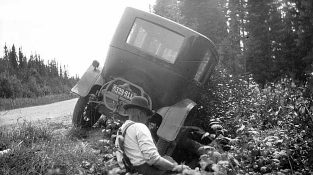 |
1929
| Minnesota Historical Society
|
|
|
 |
Either way, by intent or by accident, to be ditched meant finding oneself and one’s vehicle in a foot or so of mud and stagnant water. Bruises and broken axles usually accompanied ditching or being ditched, and prudent motorists tried to remain in the center of ordinary roads rather than risk swerves caused by blowouts. Any swerve meant the possibility of ditching.
 |
|
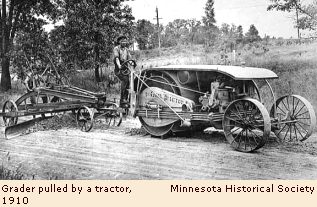 |
| |
"graders shaped the pitch of roads to speed the runoff of
rainfall and to smooth out
bumps and fill holes."
|
|
 |
Graded roads. The middle of many highways and roads stood slightly higher than the edges, for road grading machines sculpted road surfaces into slight arches, called crowns. At first horse-drawn, then propelled by gasoline and diesel
engines, road graders shaped the pitch of roads to speed the runoff of rainfall and to smooth out bumps and fill holes. After the road grader passed, the cross-section of a road showed a slight arch, but many motorists noted that a hard rain often destroyed the gentle arch and reduced the road to mud and ruts overnight. So in county after county, small town after
small town, operating the road grader became a permanent occupation. Five or six days a week, somewhere in a
county or a municipality the roadgrader worked, its work never, ever done, especially after summer thunderstorms, spring freshets, and the frost heaves of deep winter.
If elevated,
ditched, and graded, a macadamized highway might allow speeds of twenty miles
an hour, and by the 1920s struck many motorists as a high-speed ribbon tying
together two cities or perhaps a small town with another. When paved with concrete or eventually
asphalt, it permitted even higher speeds, and automobile manufacturers produced
ever faster cars intended to compete with long-distance railroad trains. The new model cars sat far lower to the
ground and did not tip over when they swerved at full speed. Better roads led the Ford Motor Company to
replace its early, high-riding Model T with the Model A, a far safer
automobile, but one that depended on high-quality road surfaces.
|
| |
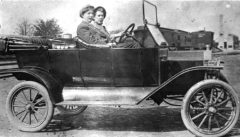 |
|
Florida State Archives 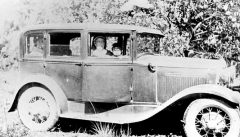 |
|
| |
Model T, ca. 1910 |
|
Model A, n.d. |
|
"Better roads led the Ford Motor Company to replace its early,
high-riding Model T with the Model A, a far safer
automobile, but one that depended on high-quality road surfaces."
|
|
|
TeacherServe Home Page
National Humanities Center
7 Alexander Drive, P.O. Box 12256
Research Triangle Park, North Carolina 27709
Phone: (919) 549-0661 Fax: (919) 990-8535
Revised: July 2001
nationalhumanitiescenter.org |









